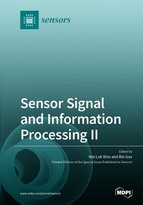Sensor Signal and Information Processing II
A special issue of Sensors (ISSN 1424-8220). This special issue belongs to the section "Intelligent Sensors".
Deadline for manuscript submissions: closed (15 June 2019) | Viewed by 104563
Special Issue Editors
Interests: machine learning; artificial intelligence; computational intelligence; data analytics
Special Issues, Collections and Topics in MDPI journals
Interests: audio and image processing; social signal processing; multi-physics mathematical modeling; non-destructive evaluation
Special Issues, Collections and Topics in MDPI journals
Special Issue Information
Dear Colleagues,
Sensor Signal and Information Processing (SSIP) is an overarching field of research focusing on the mathematical foundations and practical applications of signal processing algorithms that learn, reason and act. It bridges the boundary between theory and application, developing novel theoretically-inspired methodologies targeting both longstanding and emergent signal processing applications. The core of SSIP lies in its use of nonlinear and non-Gaussian signal processing methodologies combined with convex and non-convex optimization. SSIP encompasses new theoretical frameworks for statistical signal processing (e.g., Hidden Markov Model, latent component analysis, tensor factorization, Bayesian methods) coupled with information theoretic learning, and novel developments in these areas specialized to the processing of a variety of signal modalities including audio, bio-signals, multi-physics signals, images, multispectral, and video among others. In recent years, many signal processing algorithms have incorporated some forms of computational intelligence as part of its core framework in problem solving. These algorithms have the capacity to generalize and discover knowledge for themselves and learning to learn new information whenever unseen data is captured.
The focus of the Special Issue will be on a broad range of sensors, signal and information processing involving the introduction and development of new advanced theoretical and practical algorithms. Potential topics include, but are not limited to:
- Biomedical signal processing and instrumentation
- Pattern recognition and analysis
- Machine learning for signal and image processing
- Multimodality sensor fusion techniques
- Compressed sensing and sparsity aware processing
- Data science and analytics for big data
- Deep learning: Theory, algorithms and applications
- Multi-objective signal processing optimization
- Multimodal information processing for healthcare, monitoring and surveillance
- Computer vision and 3D reconstruction with multimodal data fusion
- Wearable sensors and IoT for personalized health monitoring and social computing
- Non-destructive testing and evaluation for material characterization, structural integrity, defect detection and identification, stress and lifecycle assessment
- Signal processing for smart grid, load forecasting and energy management
- Precision farming combining sensors and imaging with real-time data analytics
- Other emerging applications of signal and information processing
Prof. Dr. Wai Lok Woo
Prof. Dr. Bin Gao
Guest Editors
Manuscript Submission Information
Manuscripts should be submitted online at www.mdpi.com by registering and logging in to this website. Once you are registered, click here to go to the submission form. Manuscripts can be submitted until the deadline. All submissions that pass pre-check are peer-reviewed. Accepted papers will be published continuously in the journal (as soon as accepted) and will be listed together on the special issue website. Research articles, review articles as well as short communications are invited. For planned papers, a title and short abstract (about 100 words) can be sent to the Editorial Office for announcement on this website.
Submitted manuscripts should not have been published previously, nor be under consideration for publication elsewhere (except conference proceedings papers). All manuscripts are thoroughly refereed through a single-blind peer-review process. A guide for authors and other relevant information for submission of manuscripts is available on the Instructions for Authors page. Sensors is an international peer-reviewed open access semimonthly journal published by MDPI.
Please visit the Instructions for Authors page before submitting a manuscript. The Article Processing Charge (APC) for publication in this open access journal is 2600 CHF (Swiss Francs). Submitted papers should be well formatted and use good English. Authors may use MDPI's English editing service prior to publication or during author revisions.
Keywords
- Sensors
- Signal processing
- Image processing
- Video processing
- Information fusion
- Machine learning
- Compressive sensing
- Latent component analysis
- Low-rank sparse decomposition
- Deep learning neural network
- Computational intelligence
- Social signal processing
- Non-destructive testing and evaluation








